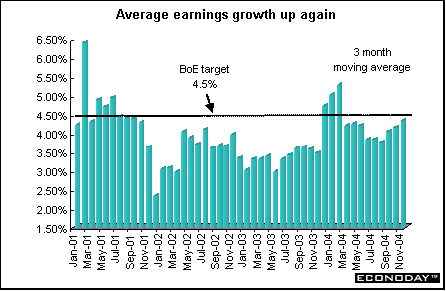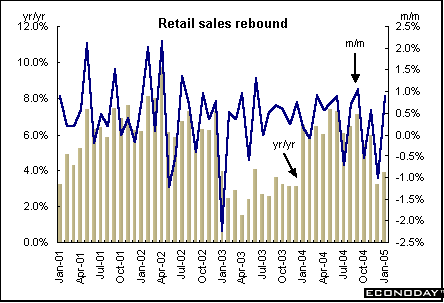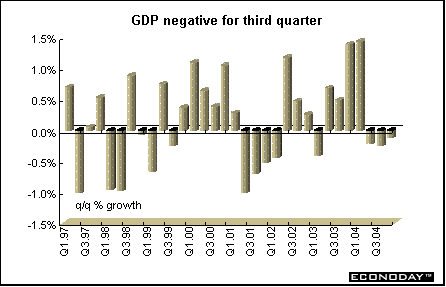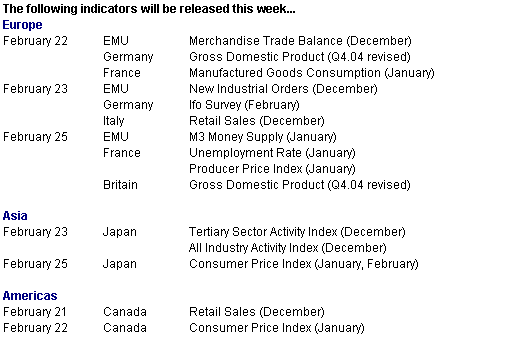Monday, February 21, 2005

Last week was dominated not only by Alan Greenspan's semiannual testimony to Congress but by other central bank reports, meetings and testimony as well. Below is a brief summary of the Bank of England's Inflation Report, Bank of Japan's meeting and RBA Governor Ian Macfarlane's semiannual testimony to parliament.
An update on Bank of England thinking
The Bank of England issued its quarterly Inflation Report last week and said there are risks to economic growth and that inflation will fall short of its latest forecasts. This was interpreted to mean that the bank might not raise interest rates during the next few months. In the report, the Monetary Policy Committee upped their estimates for economic expansion and consumer-price growth in the next two years. At the same time they said "the balance of risks was somewhat to the downside." The bank added that "considerable uncertainties'" surround today's forecasts. The report damped expectations of a further increase in interest rates that had been fueled by a December rebound in factory output, two months of property-price gains and record employment. The bank raised rates five times between November 2003 and August and has held its policy rate at 4.75 percent since then.
The booming housing market, consumer spending and an expanding services industry have allowed the British economy to outpace the EMU. British quarterly growth accelerated to 0.7 percent in the fourth quarter, while the pace of expansion in the euro region slowed to 0.2 percent. Inflation stayed at a seven-month high of 1.6 percent in January, underpinned by higher costs for food, utility bills and financial services. The cost of raw materials used by British factories rose in January at the fastest pace in more than four years.
Bank of Japan - no policy change - again
The Bank of Japan kept its policy interest rate at almost zero and maintained the level of cash it pumps into the economy. Governor Toshihiko Fukui and the bank's eight other policy makers voted unanimously to keep their target of reserves available to lenders between �30 trillion ($285 billion) and �35 trillion. They also kept the bank's monthly purchases of government bonds at �1.2 trillion. According to new GDP data the economy has declined for three straight quarters putting it in a technical recession. The Bank cut rates to almost zero in March 2001 and has used its target for reserves available to lenders as its main policy tool. It has since raised the target sevenfold to increase the amount of cash it provides. The bank adjusts the pool of money in its vaults by selling and buying securities to and from lenders in money market operations. The central bank has vowed to stick with the current policy until core consumer prices stop falling. Core prices, which exclude fresh food, have risen in only one month since April 1998.
Reserve Bank of Australia governor also testifies
Fed Governor Alan Greenspan wasn't the only central bank chief to testify last week. RBA Governor Ian Macfarlane got his chance to give his twice yearly testimony to parliament's House Economics Committee in Sydney. He said that economic growth had slowed to almost half the pace he earlier forecast for 2004 - only 2 percent rather than 3.75 percent. The Australian dollar dropped in response as investors said the central bank might increase interest rates only once this year (instead of two). RBA's current policy rate is 5.25 percent. Macfarlane damped expectations for multiple rate increases when he said economic growth had been slowed by capacity constraints in the transport and mining industries, which have hampered exports of coal and metals. Macfarlane said that interest rates were more likely to rise than fall but he wasn't more specific. The RBA expects that core inflation could reach 3 percent by the end of 2006, which is at the top of the Bank's target inflation range of between 2 percent and 3 percent.
Global Markets
It was Fed watchers' heaven. All markets were honed in on Alan Greenspan's semiannual congressional testimony on Wednesday and Thursday. The testimony was sliced and diced and then parsed some more. In the end, analysts decided there was really nothing new. That being the case, the dollar continued to ebb downward after rising pre-testimony. Equities were lackluster during the week. Of the 13 indexes followed here, five declined including those in the U.S., Australia, Germany and Mexico.
Global Stock Market Recap

Europe and Britain
The FTSE remained comfortably ensconced over the 5000 level as earnings dominated market sentiment. Even Fed Chairman Alan Greenspan's interest rate testimony to Congress which contained nothing already known (rates are low and are going to continue to climb) did little to dent investor focus. Despite positive reports from German companies including those in the energy and media sectors, the DAX declined on the week. The reports couldn't offset torpor from poor German data that continue to show the economy mired with virtually no growth. Gains mid-week were limited by concern that interest rate increases in the U.S. would continue apace crimping demand in Europe's largest export market. These concerns resurfaced Friday after the U.S. core producer price index jumped the most in more than six years. The CAC was buoyed by favorable detail of France's fourth quarter GDP data (See indicator scoreboard below).

Asia/Pacific
Asian stocks, returning to a full week of trading after celebrating the lunar new year, ended mostly on the positive side. The Nikkei and Topix enjoyed their best days on Monday and Friday but were depressed mid-week on the poor GDP data. The data showed that the economy was in a technical recession after declining for the third straight quarter for the fourth time in over a decade. Positive news from retailers buoyed stocks on Friday. On the week, both indexes were higher for the fourth week.
Mitsubishi Tokyo Financial and UFJ Holdings released details of their merger, which, when completed, will create the world's biggest bank. Shareholders must approve the deal in June. Mitsubishi Tokyo will buy UFJ for about $38 billion and will cut about 6,000 jobs after the merger. The new bank, which will be called Mitsubishi UFJ Financial Group, will have about $1.8 trillion in assets, surpassing Citigroup which has about $1.2 trillion.

The Kospi ended the week at a five-year high and was the region's biggest gainer. Hanjin Shipping Co. surged to a 20-year high after saying freight container revenue climbed last month and after its stock rating was lifted. The Hang Seng ended the week at a seven-week high. Despite hefty gains, the Hang Seng is still below its 2004 close.
Currencies
The dollar was relatively unaffected by the Greenspan testimony, although the currency did slide against the euro once again at its conclusion on Thursday. After sifting through the prepared testimony about the economy as well as the question-and-answer session that followed, analysts found elements that both help and hurt the dollar. The dollar first spiked higher on Greenspan's comments that real U.S. interest rates remain "fairly low." This led to some speculation that the pace of monetary tightening might be accelerated. But the dollar gave back these gains late Wednesday as the market realized that Greenspan was not really saying anything new.

Rather the focus remained on the yen and its weakness after the release of dismal fourth quarter GDP data. Market players had begun to downplay the spotty Japanese data released in January and focus instead on more upbeat releases, such as the surprise widening in Japan's current account surplus, thinking that perhaps growth was coming back. The GDP data emphasized the fact that the Japanese economy is not in good shape. Despite this, the yen was virtually unchanged on the week while the euro was up.
Indicator scoreboard
EMU - Fourth quarter flash gross domestic product was up 0.2 percent and 1.6 percent when compared with the fourth quarter a year ago. Weaker-than-expected German, Italian and Dutch GDP data more than offset above expected gains in France, Spain and Finland. The flash estimate contains no information on GDP components. The flash estimate is derived from available data from Germany, France, Italy, Spain, the Netherlands and Greece.

December industrial output was up 0.5 percent and 1 percent when compared with December last year. Output was up for all categories with the exception of capital goods, which was down 0.4 percent. Output was up in Germany, France, Greece, Ireland, Luxembourg, Portugal and Finland but was down in Belgium, Spain, Italy and the Netherlands.

Germany - Fourth quarter flash gross domestic product was down 0.2 percent but was up 0.6 percent when compared with the same quarter in 2003. As with other flash GDP releases, no detail is available. Component data will be available next week.

February ZEW expectations index jumped to 35.9 from 26.9 in the previous month. The index measures the economic outlook among German financial experts and is conducted by the Center for European Economic Research (ZEW) in Mannheim. The institute said that a chief reason for February's improvement was greater optimism over German domestic demand after the sharp jump in recently released December manufacturing orders. The ZEW surveyed 318 German financial experts for their opinions on current economic conditions and the economic outlook for major industrial economies between January 24th and February 14th.

January producer price index jumped 0.8 percent and was up 3.9 percent when compared with last year. The increases were due to higher energy and steel prices. Energy prices jumped 2.8 percent and 7.3 percent on the year. Excluding energy, the PPI was up a much tamer 0.2 percent and up 3 percent on the year.

December manufacturing orders were revised upward to an increase of 8.2 percent from the originally reported increase of 7.1 percent. Foreign orders were revised upward to an increase of 8.3 percent from the original 5.3 percent mainly due to soaring capital goods orders. However, domestic orders were revised downward to an increase of 8.1 percent from the originally reported 8.8 percent.

France - Preliminary fourth quarter gross domestic product was up 0.8 percent and 2.2 percent when compared with the fourth quarter of 2003. Private consumption was up 1.2 percent after declining 0.2 percent in the third quarter. However, the jump was fueled by a one-time government offer that allowed households to tap company savings plans. Total fixed capital investment also rebounded in the fourth quarter, gaining 0.9 percent after a 0.5 percent drop in the previous quarter. Business investment was up 1.2 percent, offsetting the 1.1 percent drop in the third quarter.

Italy - Fourth quarter preliminary real, seasonally and workday adjusted gross domestic product was down 0.3 percent but up 1 percent when compared with the same quarter a year ago. ISTAT provided no detailed data on the components but a spokesperson said that value added from industry was slightly negative, services were substantially flat and agriculture was positive.

December seasonally and workday adjusted industrial production sank 0.6 percent and is down 3.1 percent when compared with December 2003. The monthly drop was due to a sharp decline in capital goods production. Investment goods output was down 1.8 percent but consumer goods was up 1.3 percent. Nine of 18 product groups were up on the month with refineries leading the way followed by other manufacturing industrial and furniture. Precision electrical equipment, machinery & mechanical equipment and metal & metal products output all dropped on the month.

December seasonally adjusted industrial orders jumped by 5.6 percent with domestic orders climbing 0.4 percent while foreign orders soared 16.5 percent. Domestic orders account for around 70 percent of the overall index with foreign orders making up the rest. On the year, orders were up 3.1 percent. Transport vehicles including boats, trains and airplanes but not cars soared 62.4 percent on the year.
December world merchandise trade deficit was �713 million. The deficit a year earlier was �525 million. Exports were up 11.8 percent while imports jumped 12.4 percent on the year. Italy's world trade balance for the year was in deficit for the first time since 1992.

Britain - January producer output prices edged downward by 0.1 percent but remained up 2.6 percent when compared with last year. The drop was due primarily to declines in petroleum and alcohol production. Core output prices which exclude gasoline, tobacco, food and beverages were up 0.2 percent and 2.5 percent on the year. Seasonally adjusted input prices jumped 3.4 percent and were up 9.5 percent on the year. This sharp increase was due to a spike in crude oil prices which were up 14.8 percent in January.

January consumer price index dropped 0.5 percent but was up 1.6 percent when compared with last year. A decline in transport prices thanks to lower gasoline prices was offset by increased food prices. Prices were down for clothing, furniture, household equipment and routine maintenance sectors. The CPI is used by the Bank of England as its measure of inflation. The current inflation target is 2 percent. The retail price index excluding mortgage interest payments declined 0.5 percent and was up 2.1 percent on the year.

Average earnings for the three months ending in December were up 4.3 percent. Excluding bonuses, earnings were up 4.5 percent. December public sector earnings jumped 4.7 percent while private sector earnings were up 4.3 percent. Manufacturing earnings were up 3.4 percent.

January claimant count unemployment was down 11,000. The claimant unemployment rate was 2.6 percent, its lowest level since mid-1975. However, for the three months to December, the International Labour Organization (ILO) measure of unemployment and the government's "official" measure was up by 32,000 when compared with the previous three months ending in November. The ILO employment rate remained at 4.7 percent however. Employment for the three months ending in December jumped 90,000 to its highest level since records began in 1971.

January retail sales jumped 0.9 percent and 3.9 percent when compared with last year. All categories with the exception of other stores were up on the month, with the largest gain from non-specialized stores (mainly department stores) which were up 2.7 percent.

Asia
Japan - Fourth quarter gross domestic product was down 0.1 percent but up 0.8 percent when compared with the same quarter a year ago. GDP was dragged down by weak consumer spending and external demand. On an annualized basis, GDP sank by 0.5 percent. This was the third consecutive quarter of contraction. Japan's economy is described as technically in a recession, which is defined as two consecutive quarters of contraction (analysts are calling it technical because of the recent change in methodology and the resulting ongoing data revisions). Private consumption, which accounts for 57 percent of GDP, declined 0.3 percent. But this was attributed to typhoons and an earthquake in October that discouraged people from going out on weekends, while warm weather in November and early December hit sales of winter clothing. Net exports - the value of goods and services that Japan exports minus the value of its imports - shaved 0.2 percent from growth. Trade is normally a plus for Japan, but rising oil prices caused a surge in the value of imports in the last half of 2004 at the same time as exports to China and the U.S. rose more slowly. Private investment was up 0.7 percent buoyed by strong corporate profits. The GDP deflator declined 0.3 percent from the previous year.

Americas
Canada - December manufacturing shipments slipped 0.2 percent. The decline was driven by falling petroleum prices. Excluding the petroleum and coal products industries, manufacturers posted a modest 0.4 percent increase in total shipments. When compared with last year, shipments were up 9.6 percent. Eleven of 21 manufacturing industries accounting for 48 percent of total shipments were down on the month, with the decline concentrated in the petroleum and coal products. New orders were up 0.4 percent after four consecutive decreases. New orders were up 9.7 percent on the year. Unfilled orders were down 0.4 percent and up 4.3 percent on the year.

Bottom line
Last week was dominated by Alan Greenspan's testimony although in the end there was little market reaction mainly because he didn't say anything unexpected. With the major seasonal oratory over, investors will go back to focusing on earnings and economic indicators. GDP data will provide a more detailed look at the German, British and U.S. economies in the fourth quarter.
Looking Ahead: February 21 through February 25, 2005




